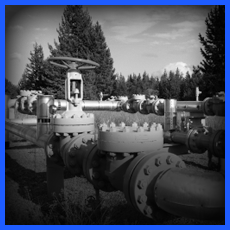OVERVIEW
Natural gas production is booming across the U.S., providing a low-cost, cleaner fuel for electricity, manufacturing, and vehicles. One key to ensuring that natural gas is as clean as possible is preventing leaks along the natural gas supply chain. Methane, the primary component of natural gas, mostly breaks down into CO2 when combusted as fuel. But when it escapes into the atmosphere before it can be captured and burned, it is 21 times more potent as a greenhouse gas than CO2.1 A number of cost-effective technologies have already been developed to address the problem of fugitive methane emissions, including those from the transmission and distribution processes. These technologies could be put to work more quickly and effectively with additional federal resources, as well as increased cooperation between EPA and industry.
ANALYSIS
The shale gas revolution has handed the United States a new tool to dramatically curb its greenhouse gas emissions. While burning natural gas does produce carbon dioxide, its emission levels are half those of coal.2 Unfortunately, some natural gas escapes during the production, processing, transmission, and distribution processes. These fugitive emissions amount to 32 megatons of CO2 equivalent annually3 —roughly the same amount of GHG’s emitted by 6.3 million cars.4 At a certain level, fugitive emissions could actually negate the climate benefits of natural gas combustion over that of “dirtier” fuels like coal for power generation; and they may already be making natural gas more carbon-intensive than petroleum as a vehicle fuel.5 While new EPA regulations could reduce fugitive emissions from natural gas production,6 they do not address the emissions from natural gas pipelines.7
Much of the natural gas industry is implementing new best practices and technological advances that significantly reduce fugitive emissions from pipelines. Replacing cast iron pipelines with plastic, for instance, can reduce methane emissions by about 96%.8 While cast iron and unprotected steel pipelines are only about 8% of distribution pipeline mileage, they were responsible for 67% of the methane emissions of this particular set of infrastructure.9 Much of the reductions in emissions from the industry as a whole since 1990 have come from improvements to these particular pipelines.10 The challenge now is addressing the remaining inefficient pipelines, which tend to be located in dense urban areas or other locations that make replacement extremely difficult.11
EPA is attempting to reduce fugitive emissions through its Natural Gas STAR Program, a voluntary initiative that works with the natural gas industry.12 Thanks to voluntary improvements made by producers, many of whom have participated in Natural Gas STAR, overall emissions from natural gas systems are down 13% from 1990 levels.13 But industry has concerns with the methodology used by EPA when analyzing the data that producers have submitted through Natural Gas STAR,14 causing at least one major producer to leave the program entirely.15 Failure of the Natural Gas STAR program would deprive the federal government of an effective tool that has encouraged producers to outperform federal environmental regulations.
IMPLEMENTATION
Carefully crafted policies could generate environmental benefits by reducing fugitive emissions while allowing industry to capture more product and more profit.






